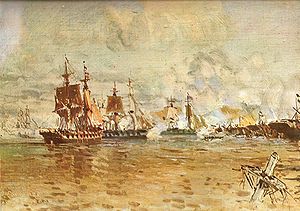Battle of Vuelta de Obligado
| Battle of Vuelta de Obligado | |||||||
|---|---|---|---|---|---|---|---|
| Part of the Anglo-French blockade of the Río de la Plata | |||||||
 The Battle of Vuelta de Obligado, as depicted by Manuel Larravide (1871–1910) |
|||||||
|
|||||||
| Belligerents | |||||||
|
|
|||||||
| Commanders and leaders | |||||||
|
|
|
||||||
| Strength | |||||||
| 2160 men 4 coastal batteries 1 brigantine 2 gunboats |
11 warships | ||||||
| Casualties and losses | |||||||
| 150 killed 90 wounded 1 brigantine lost 21 cannons 20 barges |
28 killed 95 wounded Multiple damage to the warships, forcing emergency repairs. |
||||||
The naval Battle of Vuelta de Obligado took place on the waters of the Paraná River on November 20, 1845, between the Argentine Confederation, under the leadership of Juan Manuel de Rosas, and a combined Anglo-French fleet. The action was part of the larger Anglo-French blockade of the Río de la Plata. Although the attacking forces broke through the Argentine naval defenses and overran the land defenses, the battle proved that foreign ships could not safely navigate Argentine internal waters against its government's wishes. The battle also changed political feeling in South America, increasing support for Rosas and his government.
During the 1830s and 1840s, the British and French governments were at odds with Rosas' leadership of the Argentine Confederation. Rosas' economic policies of requiring trade to pass through the Buenos Aires custom house – which was his method of imposing his will on the Littoral provinces – combined with his attempts to incorporate Paraguay and Uruguay to the Confederation, were in conflict with French and British economic interests in the region. During his government, Rosas had to face numerous problems with these foreign powers, which in some cases reached levels of open confrontation. These incidents included two naval blockades, the French blockade in 1838, and the Anglo-French of 1845.
With the development of steam-powered sailing (which mainly took place in Great Britain, France and the United States) in the third decade of the 19th century, large merchant and military ships became capable of sailing up rivers at a good speed and with a heavy load. This new technology allowed the British and French governments to avoid the custom house in Buenos Aires by sailing directly through the La Plata estuary and engaging in commerce directly with inland cities in Entre Ríos, Corientes, Uruguay and Paraguay. This avoided Buenos Airean taxation, guaranteed special rights for the Europeans and allowed them to export their products cheaply.
...
Wikipedia
